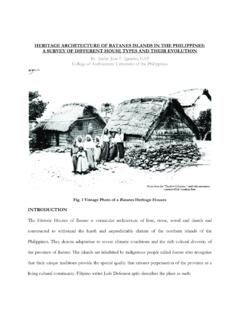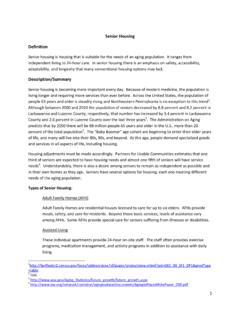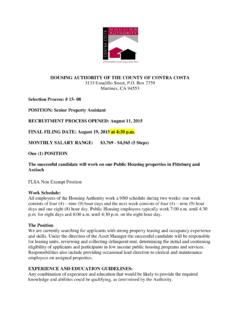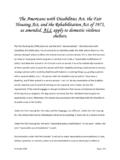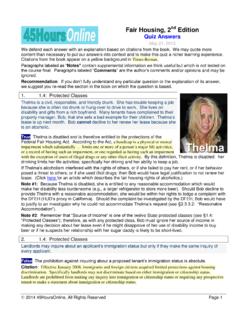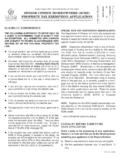Transcription of Implementation of the Zambian Housing Policy
1 Implementation of the Zambian Housing Policy Empowerment through Home Ownership Cecilia Chipasha Mbati -Mwengwe Senior Planner, Department of Physical Planning and Housing Ministry of Local Government and Housing , Lusaka Province, Zambia Introduction Housing is a basic social need after food and clothing and, as with the other basic needs, adequate Housing is a pre-requisite to national socio-economic development. Its inadequacy can have a severe impact on the environment, health and the general well being of communities (Zambia National Housing Policy 1996:1). It goes without saying therefore from this statement that shelter is an extremely important aspect of our daily lives. For any nation to be able to tackle its Housing problems, there has to be an established functional but flexible and responsive framework through which the various relevant actors have to operate and interact. This will ensure effective response to the existing demand patterns and also sustainability of any programme being undertaken at each particular given time.
2 Problem Definition It has now been Five (5) years since the National Housing Policy for Zambia was launched but its Implementation has been extremely slow with the areas, which need more financial resources being the worstaffected. The bulk of Housing development has continued to take place in unplanned settlements. A step in the right direction has already been taken by the Government to try and empower the citizens of Zambia with Housing although this process has also com e with its own shortcomings. The lack of funds and in some cases lack of commitment on the part of those responsible for ensuring that the Policy is implemented are the major factors leading to the situation we have at the moment. The success of any country's Housing Policy depends on how well it is implemented. A Housing Policy , which is not practical, is as good as nothing and a waste of both human and financial resources used to formulate it. The way the Housing problem is tackled however depends on the situation prevailing in that particular country like the Housing situation, the magnitude of the Housing shortage problem, the political set -up and also the economic condition.
3 Purpose of the Paper This piece of work will seek to discuss and analyse how the Housing Policy has already been partly implemented and how it can, in future, be strategically implemented using a participatory and innovative approach through home ownership with special reference to the sale of government pool houses, council houses and the replacement of these houses with construction of new Housing units under the Presidential Housing Initiative (PHI). The paper will look at the existing Housing situation, the strategies for improving the situation according to the Housing Policy and the projects or actions, which have emerged or come out as a result of the Policy 's good intentions. Finally it will look at what can be done to improve on the performance of these projects using the success stories from the Architecture and Development 2001 lectures. Emphasis will be placed on what has been done in the area of Home Ownership. 1.
4 Cecilia Chipasha Mbati-Mwengwe Motivation For the Choice of Study A Housing Policy is an extremely essential representation of a country's intended solutions to its Housing requirements and problems and its success greatly depends on the capacity of its skilled human resource which is in place in the relevant organisations or institutions responsible for Housing . Working as a Planner in the department responsible for Housing and given the problems in the Housing sector and the slow rate at which the Policy is being implemented obviously calls for concern. This is a challenge, which calls for us as a department and as a ministry to have an insight and a vision as to which direction the nation should take in the area of Housing and how the direction should be taken. I feel that I need to participate actively and be committed to ensuring that the existing Housing Policy is being implemented effectively and also that there is coordination among the key stakeholders in the Housing sector in the Lusaka Province.
5 In my view there is no better person to discuss the Implementation of the Housing Policy than a member of staff from the Department of Physical Planning and Housing . Background At Independence in 1964, Zambia experienced an unprecedented rural-urban migration. This migration increased the population to proportions beyond the absorptive capacities of urban areas and created a severe shortage of Housing and urban services. The shortage of Housing and urban services has persisted to this day. In Zambia, inadequate Housing is more pronounced in the low-income groups, which constitute the majority of the country's population. Zambia has an acute Housing problem, which has led to an increase in unplanned settlements mainly prevalent in major cities. Rural Housing is equally poor. The result has been deteriorating hygiene, sanitary and health conditions and a frequent loss of property due to the structural failures the shelter units develop.
6 This problem is acute in low - income communities where there is extensive use of temporary building materials. This is due to the fact that the low-income cannot afford the conventional permanent building materials and have no access to information about affordable alternative local building materials. This therefore clearly shows that there is a need for intervention, which is not only workable but also sustainable. In 1996, a comprehensive National Housing Policy was formulated whose main goal was to provide adequate affordable Housing for all income groups in Zambia. This was the First ever National Housing Policy , which shows that the present Government has made a recognisable effort to try and solve the existing Housing problems. Zambia In General Figure 1 Map of Zambia 2. Implementation of the Zambian Housing Policy Zambia is a landlocked country located in southern central Africa in a tropical belt of fairly high plateau averaging 1300 Metres above sea level.
7 It has an area of 752,000Km and a population of approximately 10 Million. It is divided into 9. provinces each with a provincial headquarters. The capital City is Lusaka, which is the hive of most commercial activities. The other major towns are Livingstone (one of the most important tourist centres), Kitwe and Ndola (copper mining towns), and Kabwe, Mufulira, Chingola, Luanshya, Kalulushi and Chililabombwe. It has a Subtropical climate with three distinct seasons as follows: May to August Cool and Dry. September to November Hot and Dry. December to April Warm and Wet Religion: Most widely followed is Christianity but Islam, Hinduism and Buddhism is also practised. Language: official Language is English (including media and business), with 35. other African languages and 70 dialects. Unit of Currency: 1 Zambian Kwacha (K) =100 Ngwee; and K3040= 1US$. Existing Housing Situation Pressure exerted on infrastructure and social services country-wide by rapid population growth (compounded in the case of urban areas by migration from the country side for the urban areas), has been most felt in the Housing sector than in any other sector as shown by the following statistics: - Out of the nations million Housing units, only 403,000 units, or percent of the total Housing stock, were formal and fully approved in 1990.
8 The remaining 897,000 or percent of the Housing stock were informal and poorly serviced or not serviced at all. About 11,000 of these informal or poorly serviced Housing stocks were not suitable for use as Housing units. Approximately percent of the million households in Zambia are supplied with piped water; about percent use wells or bore holes and about percent use rivers or streams. About percent of households use flush toilets, about percent use pit latrines and about percent do not have toilet facilities at all. About percent of the nation's Housing stock is in rural areas where the dispersed settlement pattern makes it difficult to provide basic infrastructure and social services. Basic services are therefore generally poor or none existent. Of the remaining percent in urban areas, approximately percent of the dwelling units are equally poorly serviced. Taking into account all the homeless families and the need to replace substandard dwelling units, the current Housing backlog stands at approximately 846,000.
9 Units. To clear the backlog over the next ten (10) years requires a building rate of about 110,000 dwelling units per annum. In Zambia the demographic picture has been characterised by the following Features: - A rapid population growth over percent since the 1960's which has resulted in the trebling of the population in 36 years from million in 1964 to an estimated million in the year 2000. The population is projected to reach million by the year 2010 and million by the year 2015. A significant urban population of about percent concentrated in copper belt and Lusaka which is growing at a rate of percent per annum and rural population of about percent which is in settlements spread over the rest of the country. Objectives of the Housing Policy In order for the Housing Policy to achieve the goal of providing adequate affordable Housing for all income groups in Zambia, it had the following objectives to attain: - An allocation of a minimum of 15 percent of the national annual budget to Housing to support a sustainable Housing development programme.
10 3. Cecilia Chipasha Mbati-Mwengwe Making serviced land available for Housing development and streamlining the land allocation system. Streamlining of building standards, regulations and other controls so that they accord with the capabilities, needs and aspirations of the various sections of the population. Encouraging the production and use of local and affordable building materials. Assisting the poor to acquire decent shelter through alleviation of their affordability problems. Fostering Housing areas that are functional, healthy, aesthetically pleasant and environmentally friendly. The preparation of a national Housing Implementation strategy. Strategies in the Policy The measures outlined below were intended to change the pattern of Housing development in Zambia and restore growth of the Housing sector. By providing the framework for sustainable Housing development, the Policy was also providing a mechanism for ensuring that limited resources are put to their optimum use and thus also address poverty alleviation.
